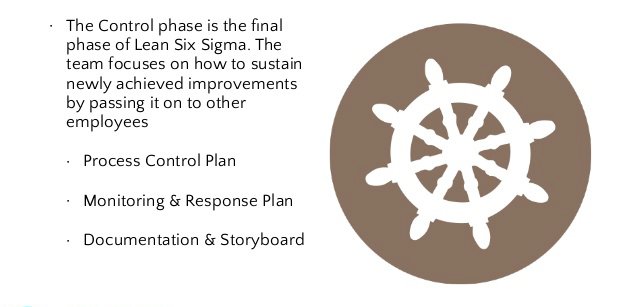What Happens in Control phase in a Six Sigma Project?
Importance of Control Phase in a Six Sigma Project

Importance of Control Phase in a Six Sigma Project
What Happens in Control phase in a Six Sigma Project? Control stage is the final stage in a Six Sigma project. The Improve stage had ended with the conclusion that the solutions implemented in the process had borne fruit and the process had improved to the desired level as mentioned in the Goal statement of the Project Charter. Now, steps are taken in the Control stage to ensure that the improvement seen as a result of the implemented solutions becomes a part of the process and was not just a one off action or a fluke.
Control Plan
A Control Plan has to be designed having the details of all the characteristics that are required to sustain the improvements in the process. Steps are incorporated in this to ensure that process remains within control all the time. This is done through designing of certain metrics, dashboard, monitoring mechanism, etc to monitor the process performance at fixed periods. An Audit mechanism is also generally designed to monitor all this. Control Plan is generally prepared with the Process Head and all the other stakeholders involved in the process.
Collect Data for Y and X’s
Data for Y and X’s is again collected to validate the improvement in the process and to ensure that the improvement has been sustained in the process.
Updating FMEA
FMEA is again used in Control phase to update the changes in the process. All the risks for the process and their treatment through Risk Treatment Plan are incorporated in it.
Updating Documents
Al the documents related with the process should be updated as per the ISO standards requirements. The documents so updated may include Process Design (if changed), SOPs (Standard Operating Procedures), Work Instructions, etc and other documentation required for the smooth running if the process. Apart from this, related records and documents also have to be updated, related with the process such as training given to workers, etc.
Training
Any training if required is given to the people working in the process to help them to adjust themselves as per the requirements of the improved process. Even of the process is almost the same, still some training has to be imparted to the key personnel who will keep on monitoring the process performance.
Cost Benefit Analysis
A detailed Cost Benefit Analysis is prepared to numerically represent the gains from the Six Sigma project. Comparisons are made between the pre project data and post project data and calculate the improvement registered as a result of the Six Sigma project. It is also done to validate the achievement of the Goal with which the project was started.
Closure and Handover
After all this, the Six Sigma project is closed and the improved process is handed over to the Process Owner.
Lessons Learnt
At the end, a detailed analysis is done about the changes made by the project and it is assessed if the same changes can be implemented in other processes or departments to bring improvement in their functioning as well.

 Shishu Pal
Shishu Pal 

































Comments (0)
Facebook Comments